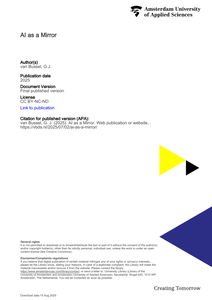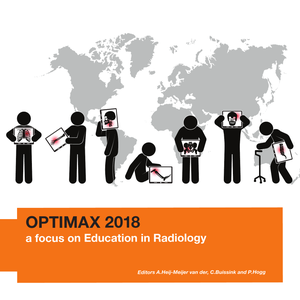Book Review of S. Vallor (2024). The AI Mirror. How to Reclaim Our Humanity in an Age of Machine Thinking. Oxford University Press, New York, 263 p.
MULTIFILE

Book review of Critical perspectives on plurilingualism in deaf education. Kristin Snoddon and Joanne C. Weber (Eds.), Bristol: Multilingual Matters. 2021. 272 pp.
DOCUMENT
This year, OPTIMAX was warmly welcomed by University College Dublin. For the sixth time students and teachers from Europe, South Africa, South America and Canada have come together enthusiastically to do research in the Radiography domain. As in previous years, there were several research groups consisting of PhD-, MSc- and BSc students and tutors from the OPTIMAX partner Universities or on invitation by partner Universities. OPTIMAX 2018 was partly funded by the partner Universities and partly by the participants.
DOCUMENT

Modemuze@OBA, OBA (the public library in Amsterdam), Amsterdam, 17 March–2 July 2017Balenciaga: Shaping Fashion, Victoria and Albert Museum, London, 27 May 2017–18 February 2018
DOCUMENT

The “Creating Age-friendly Communities: Housing and Technology” publication presents contemporary, innovative, and insightful narratives, debates, and frameworks based on an international collection of papers from scholars spanning the fields of gerontology, social sciences, architecture, computer science, and gerontechnology. This extensive collection of papers aims to move the narrative and debates forward in this interdisciplinary field of age-friendly cities and communities. (This book is a reprint of the Special Issue Creating Age-friendly Communities: Housing and Technology that was published in Healthcare)
MULTIFILE
![Creating age-friendly communities: Housing and technology [book]](https://publinova-harvester-content-prod.s3.amazonaws.com/thumbnails/files/previews/pdf/20250506132407955076.b97102b7-5bdc-4b75-a293-4281df36ef73-thumbnail-400x300.png)
CLIL Skills is a practical resource book for subject teachers working in bilingual schools. It supports them in their everyday practice and informs them about key CLIL issues. Good CLIL teaching interweaves content and language. This book covers six important CLIL Skills: activating, providing lesson input, guiding and understanding, encouraging speaking and writing, assessing and giving feedback, and using projects. This book is essential reading for CLIL teachers everywhere.CLIL Skills includes:• Over 70 practical lesson ideas• Case studies from schools• Examples and illustrations from teachers• Useful, clearly explained theory• A glossary of handy terms• Activities for teacher development.
MULTIFILE

The Nature Spectacle: On Images, Money, and Conservation Capitalism by Jim Igoe is, as its Preface states, an ambitious book that seeks to make connections between diverse times and places. The preface also, in many ways, tells more about the background and intention of the book than its chapters do, tying together the author’s origins and motivation. Igoe recalls his childhood in St. Louis, Missouri, much of which he spent “in front of a television and at a neighborhood movie theatre” (p. XII), once watching a musical, which was “essentially an extended Chevrolet commercial set among the geysers of Yellowstone” (P. 109). It is the mix of such absurd and comical observations of commercialism merging with Nature, and much heavier criticism of the capitalist cult of economic growth, development, and also conservation that characterizes The Nature of Spectacle. Much of Igoe’s outdoor experiences were shaped by green spaces, created in St. Louis as part of commodity exhibits at the 1904 World’s Fair. The author admits to feeling both critical and nostalgic of those places that have merged (sub)urban aesthetics with that of industrially developed commercial “spaces” (p. XII) – important concepts that form a leitmotif throughout the book. https://doi.org/10.1080/03066150.2018.1488355 https://www.linkedin.com/in/helenkopnina/
MULTIFILE

Review of: J. Haidt (2024). The Anxious Generation: How the Great Rewiring of Childhood is Causing an Epidemic of Mental Illness, Penguin Press, 400 pp.
MULTIFILE